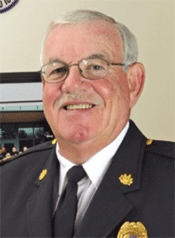 On my first day as a police chief, I was hit with a troubling realization. Through my years in law enforcement, I had learned what I needed to know to be a good police officer. Unfortunately, I knew nothing about how to be a good police chief.
On my first day as a police chief, I was hit with a troubling realization. Through my years in law enforcement, I had learned what I needed to know to be a good police officer. Unfortunately, I knew nothing about how to be a good police chief.
Suddenly, the daily challenges of my job had shifted, and I found myself confronting an array of personnel, policy, and administrative questions and decisions that I had little to no experience addressing. Thankfully, by seeking out and listening to the wise counsel of experienced chiefs, getting involved with my state association, and taking advantage of the opportunities and resources offered by the IACP, I was able to successfully navigate the multitude of challenges that confronted me on my first day as chief 21 years ago.
The IACP remains committed to ensuring that new chiefs and their more experienced colleagues continue to receive the assistance and resources they need to lead their departments and officers in an effective and efficient fashion. To that end, the IACP continues to offer several tools and resources to aid this effort.
For this reason, the IACP developed the New Police Chief Mentoring Project with support from the Bureau of Justice Assistance, U.S. Department of Justice. The focus of our activities is to provide technical assistance to new police leaders in their first three years of appointment. The time element is essential because experience has demonstrated that the beginning of any newer police chief’s administration can be crucial to achieving a successful transition and to building important relationships within the new agency and the community.
Another invaluable resource for police executives is the Police Chief’s Desk Reference (PCDR). The PCDR contains a wealth of resources to assist chiefs in their roles as police executives. The PCDR also helps executives connect to their state associations though state-specific resource supplements. More than 10,000 copies of the first edition were distributed and the second edition is available on the IACP website at www.theiacp.org/PublicationsGuides/Projects/NewPoliceChiefMentoring/PoliceChiefsDeskReferencePCDR/tabid/365/Default.aspx.
For example, just this year the IACP has launched a new program to address the unique challenges confronting rural agencies: the Leading by Legacy Program. This program provides leadership and management training to executives, command staff, and first-line supervisors specifically from rural law enforcement agencies. The program will also provide on-site training with travel scholarships, distance learning and online networking opportunities, and on-site technical assistance.
Additionally, the IACP Smaller Agency Program provides training and informative resources to the largest group of U.S. law enforcement agencies and IACP members: those serving populations of up to 50,000. The Smaller Agency Program, in partnership with SACOP’s Smaller Agency Section, provides training and resources designed by smaller agency executives for smaller agency executives, including regional training in a variety of executive-level topics, the IACP Annual Conference Training Track, the Big Ideas for Smaller Law Enforcement Agencies newsletter, and a Best Practices Guide series.
I would also encourage all IACP members to take advantage of the IACP’s National Law Enforcement Policy Center, founded in 1987. The center has carried out its mission through the development of a wide variety of model law enforcement policies. Each model incorporates the research findings, the input of leading subject experts, and the professional judgment of advisory board members who have combined this information with their extensive practical field and management experience. The end product is some of the best contemporary thinking in the field.
The policies addressed by the center are selected because they represent some of the most difficult issues facing law enforcement administrators. The policy center continues to develop models in other priority areas. I encourage you to review model policy topics and to subscribe to receive the policies on the IACP’s website.
Programs such as these reflect IACP’s longstanding belief that training is the foundation of officer safety and effective policing. Moreover, proper training impacts not only officers and departments, but also the communities that they serve. The IACP takes great pride in its long history of providing high-quality, cutting-edge training to its members and to the law enforcement community.
In 2008, the IACP’s training efforts were reorganized under one comprehensive Center for Police Leadership and Training. The mission of the center is to respond to the needs of the law enforcement community by offering a variety of training options in leadership, management and supervision, tactical response, and administrative and operational procedures.
I encourage you to view the 2010 online training catalog on the IACP’s website. The online catalog provides readily accessible, up-to-the minute, interactive training information, including the latest training announcements, interactive information portals, and the ability to access training information worldwide.

As you can see, the IACP is committed to ensuring the success of new and seasoned chiefs alike. We are committed to aiding all law enforcement agencies in establishing effective programs that will develop the next generation of law enforcement leaders. We must always remember that our success as law enforcement leaders will be determined not only by how we manage our departments today, but also by how we have prepared our departments to meet the challenges of tomorrow. ■
Please cite as:
Michael J. Carroll, “President’s Message: Chiefs Have a Place to Turn for Training,” The Police Chief 77 (June 2010): 6.


